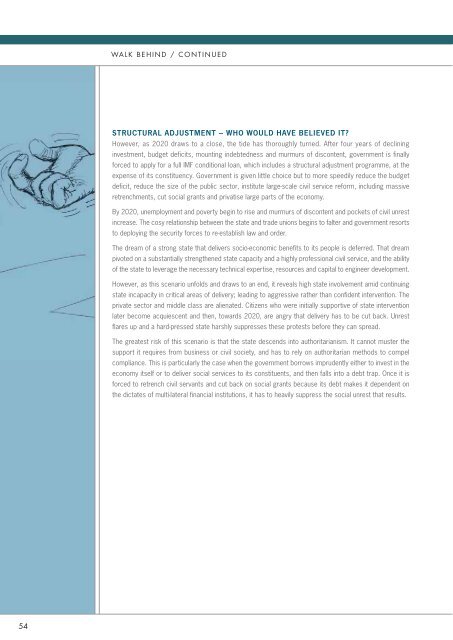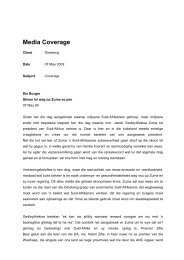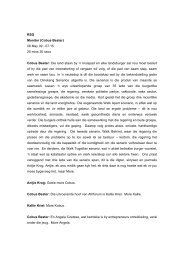Dinokeng Scenarios
Dinokeng Scenarios
Dinokeng Scenarios
You also want an ePaper? Increase the reach of your titles
YUMPU automatically turns print PDFs into web optimized ePapers that Google loves.
WALK BEHIND / CONTINUED<br />
STRUCTURAL ADJUSTMENT – WHO WOULD HAVE BELIEVED IT<br />
However, as 2020 draws to a close, the tide has thoroughly turned. After four years of declining<br />
investment, budget deficits, mounting indebtedness and murmurs of discontent, government is finally<br />
forced to apply for a full IMF conditional loan, which includes a structural adjustment programme, at the<br />
expense of its constituency. Government is given little choice but to more speedily reduce the budget<br />
deficit, reduce the size of the public sector, institute large-scale civil service reform, including massive<br />
retrenchments, cut social grants and privatise large parts of the economy.<br />
By 2020, unemployment and poverty begin to rise and murmurs of discontent and pockets of civil unrest<br />
increase. The cosy relationship between the state and trade unions begins to falter and government resorts<br />
to deploying the security forces to re-establish law and order.<br />
The dream of a strong state that delivers socio-economic benefits to its people is deferred. That dream<br />
pivoted on a substantially strengthened state capacity and a highly professional civil service, and the ability<br />
of the state to leverage the necessary technical expertise, resources and capital to engineer development.<br />
However, as this scenario unfolds and draws to an end, it reveals high state involvement amid continuing<br />
state incapacity in critical areas of delivery; leading to aggressive rather than confident intervention. The<br />
private sector and middle class are alienated. Citizens who were initially supportive of state intervention<br />
later become acquiescent and then, towards 2020, are angry that delivery has to be cut back. Unrest<br />
flares up and a hard-pressed state harshly suppresses these protests before they can spread.<br />
The greatest risk of this scenario is that the state descends into authoritarianism. It cannot muster the<br />
support it requires from business or civil society, and has to rely on authoritarian methods to compel<br />
compliance. This is particularly the case when the government borrows imprudently either to invest in the<br />
economy itself or to deliver social services to its constituents, and then falls into a debt trap. Once it is<br />
forced to retrench civil servants and cut back on social grants because its debt makes it dependent on<br />
the dictates of multi-lateral financial institutions, it has to heavily suppress the social unrest that results.<br />
54







